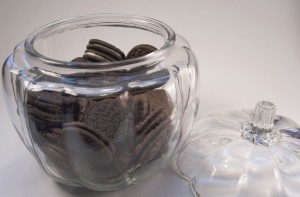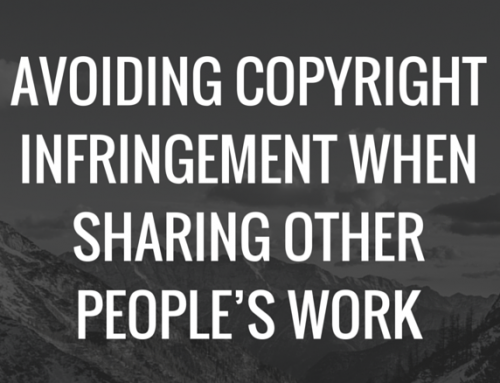
Today I came across a series of tweets about a food blogger who was upset that another blogger took her photo and recipe, reproduced it on her site while providing a credit and link back in smaller text but also tagged the original blogger on Facebook.
Earlier in the week, Confessions of a Cookbook Queen posted a photo and recipe for Shamrock Mint Oreos. Although unclear because there is no copyright notice, I’m taking her word that the image is hers. As such, it is protected by copyright and any use of it on the other website is clearly a violation of copyright. The law does not require a copyright notice, but it does help to let people know you own it.
The issue actually is a bit more complicated regarding the photo because on the photo, Cookbook Queen uses a registered trademark, Oreo. Kraft is the owner of the registered trademark for the word Oreo as it pertains to cookies, and in fact that trademark has been registered since 1913. So we have a photo of homemade sandwich cookies in the style of what an Oreo would look like with the word Oreo on the photo. This brings up the issue of Trademark Infringement.
Is the original photo infringing on the right of Kraft’s exclusive use of the word Oreo as pertaining to this type of sandwich style cookie? The result is that even though Confessions of a Cookbook Queen may have a copyright on the photo in question, it does contain a potentially infringing use of a registered trademark. That, however, does not mean the other blog can take the copyrighted image, whether giving a link back or not.
Now, let’s get to the recipe part. I’ve discussed Recipe Copyright before and mentioned that ingredient lists are not protected by copyright. So let’s look at the directions. Are they sufficiently original to be considered substantial literary expression? There is some argument the directions could rise to that level, because there is a mention of specific dimensions and cutter. Although I don’t think it’s a strong position, there is some argument that there could be a copyright claim.
While I did not discuss this in my prior post, here we have an example of what could be a derivative work. In the United States, the Copyright Act defines “derivative work” in 17 U.S.C. § 101
A “derivative work” is a work based upon one or more pre-existing works, such as a translation, musical arrangement, dramatization, fictionalization, motion picture version, sound recording, art reproduction, abridgment, condensation, or any other form in which a work may be recast, transformed, or adapted. A work consisting of editorial revisions, annotations, elaborations, or other modifications which, as a whole, represent an original work of authorship, is a “derivative work”.
The original blog says she adapted the recipe. That would mean she used a pre-existing work. Is that pre-existing work subject to copyright? I don’t know about the specific recipe. Although, the cookbook from which it came certainly is.
If the prior recipe was not copyrightable, the new work would not be copyrightable to the extent the directions are the same or similar. To be copyrightable, a derivative work must be different enough from the original to be regarded as a “new work” or must contain a substantial amount of new material. Without seeing the original recipe, I can not say for certain but with only a few special aspects to the directions claiming copyright would be a very difficult argument to make.
In this particular instance, it is clear the copyright claim would be tenuous at best. And if the recipe is not subject to copyright, there is little if any protection against someone taking it and using. The issue of plagiarism doesn’t come in to play because the second blog actually credited the recipe both in the post and by tagging in Facebook. The credit was provided, as Cookbook Queen mentioned, although in a smaller font and not quite as obvious and maybe it could have been.
So what to do when there is likely no copyright claim for the recipe, nor was there plagiarism? There is still the issue of the copyright for the photo, for which that alone Cookbook Queen could ask that the image not be used without whatever attribution she wishes, if she so wishes to even permit use of her photo. It is, after all, her copyrighted image. The issue of the use of a trademark would be handled separately by the trademark holder.
When excluding the copyright issue of the photo, this situation likely comes down to ethics, standards and best practices. Obviously Cookbook Queen did not like her recipe being taken by this ‘bigger blogger’ and she asked that there be better attribution. It appears that bigger blogger was not happy and has since taken down the post and put up an explanation post. Bigger blogger likely did not appreciate getting an email from a ‘smaller blogger’ asking for better attribution.
This situation clearly demonstrates the differences of what the standards and best practices are among bloggers. When there is no law to lean on, all we have is our ethics and standards and any best practices that are out there. Clearly, bigger blogger and Cookbook Queen do not see eye to eye on these. But what it comes down to is that if you’re so in love with someone’s work, copyrighted or not, send your readers to them.
Your readers go to your blog because they love you and appreciate all that you share. They’re not going to abandon you. And if you’re a bigger blog, showcasing smaller bloggers is terrific. Why, though, use a smaller font to tell your readers how to find the original post? And why do a cut and paste job instead of just sending your readers to the other blog?
Maybe it’s not illegal to have taken Cookbook Queen’s recipe, but it’s definitely not cool!
What are your thoughts? Do you think ‘bigger blogger’ did anything wrong? Did Cookbook Queen over-react? How would you have handled this?
Disclosure: While I am a lawyer, I am not offering legal advice. Posts on legal matters are intended to provide legal information and do not create an attorney/client relationship. This post is part of my Blog Law Series.





i think bigger blogger should be in the practice of not using other people’s photos without permission whether or not they violate anyone elses rights.
as far as the recipe goes, i think what she did is not illegal but probably not best practice. when i post a recipe on my food blog i never copy a recipe exactly (mostly because my family makes me take everything they don’t like out of the recipe) and i always rewrite the instructions. and i always give credit to the source or inspiration at the top.
Carrie,
I, too, was surprised that the bigger blogger used the photo. Given that it was not clear if the was or was not copyrighted, I would surely err on the side of believing it was copyrighted.
The recipe issue does likely focus more on the standards and best practices in blogging. And when more established bloggers are not setting the bar high, how can then then come back and cry foul? I’m quite certain that the bigger blogger would have been all over a new(ish) blogger had the situation been in reverse. The double standard can not be the norm.
I think your practice of rewriting the instructions is a best practice, as is giving credit to the source or inspiration. I think the fact remains that it’s just too easy and tempting to do a cut and paste job. Also, if something thinks they are doing you a favor or providing ‘exposure’ they won’t see how what they are doing is not the standard or best practice that show excellence in the field.
Thank you for sharing your first hand experience regarding recipes.
Sara
It’s my understanding that ingredients for a recipe cannot be under copyright, only the instructions to create the recipe. But an outright steal is completely wrong.
Ayngelina,
You are correct that the ingredient list is not copyrightable. However, the instructions must meet the copyright standards of being both original and a substantial literary expression. Many instructions just do not rise to that level and if not, the instructions would not be subject to copyright either.
Regardless of whether or not the recipe is subject to copyright, a little bit of common courtesy and best practices would go a long way in preventing hurt feelings.
~ Sara
Ooohhh… that stinks. I think that the bigger blogger (though, I have issue with that term. Is she bigger because she has more comments, has been around longer, or another reason? Not to be answered, just a thought…) should have contacted the other blogger first, and asked permission to use the recipe and picture.
There have been several times that I have asked friends to post their recipes on my blog, have always given credit, and it’s important to me to always add my own picture.
Becca, it does stink! And the ‘bigger blogger’ has been blogging longer and has significant reach via various analytics. It appears that this way of ‘showcasing’ is the her way to sharing other’s work. There is a HUGE different between asking someone to share their work and think you’re doing them a favor by posting their work on your site.
I don’t particularly like the term ‘bigger blogger’ because it implies that one is better than another. I used the term because the original blogger used it.
~ Sara
The photo belongs to whoever took the photo, but no trademark laws are violated unless she tries to sell the photo. Anyone can take a photo that contains a logo and they own the photo, but they can’t sell it. The copyright is theirs for the composition of the photo. I’m not sure they could get financial compenstation over the theft though, because of the trademark.
I just went to see the cookies, no logo image exists on the photo, but the person who put the OREO name on the photo is herself in trademark violation for misusing the name on a cookie of her own.
sisterlisa recently poste
As I stated in my article, there is likely a trademark violation because the photo uses a registered trademark to reference the homemade sandwich style cookies. No, taking a photo of an item with its trademark is not itself a trademark violation. And anyone can take a photo of a trademarked item and sell that photo. Trademark law has little application in that situation. Trademark law is about confusion as to the source of the goods or services. Famous marks, such as Oreo, have very high levels of protection.
Hello Sara,
I’m a new blogger and just trying to make sure I’m giving credit where credit is due. Thank you for your helpful article. Since recipes are such a grey area do you think it’s necessary to contact the person whose recipe you want to cite before blogging about it. I plan to use my own pictures and put the directions in my own words. I think bigger blogger should have made it really clear where the content was from and taken her own photos .
Hi Amy, recipes are a very unique area of blogging. While there may be standards of practice about noting when a recipe was inspired by another or when the recipe is the same as another, the copyright issues surrounding use of recipes are very clear. Lists of ingredients are not copyrightable. In additional, there is some minimum level of originality and detail that is needed to meet the ‘original work of authorship’ standard but that minimum is not specifically clear.
From a ‘best practices’ standpoint, if you’re specifically using another blogger’s recipe for inspiration or following it exactly you should follow the standard protocol for the type of use your post will incorporate.